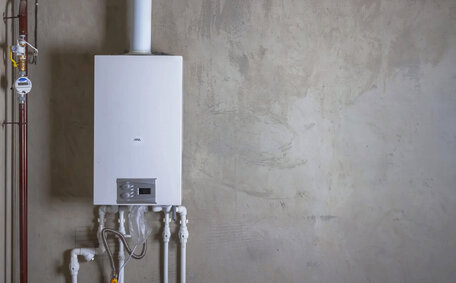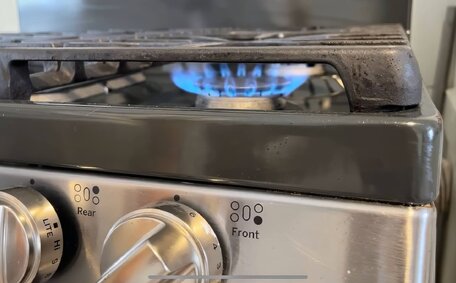Introduction to Using Gas Appliances During Power Outages
During a power outage, using gas water heaters and other gas appliances safely is paramount.
At Glenhaven Plumbing, we are experts in gas water fitting and plumbing services throughout the Glenhaven and greater Sydney area. We want to provide readers with clear instructions on how to properly use gas stoves, water heaters, and other gas appliances when the power goes out.
During a power outage, you might ponder whether your gas stove is usable for cooking. Generally, you can indeed use a gas stove, but it’s important to first address safety concerns including pilot lights, appliance types, and ventilation.
Continue reading our comprehensive guide to discover expert tips for operating your stove safely during power interruptions:
- How to tell if your gas stove will work without electricity
- What to do if the pilot light goes out
- Safely lighting your stove burners during an outage
- Alternative cooking methods if gas isn’t an option
- And much more!
As your local experts in all things gas and plumbing related, we encourage you to also get in touch today if you have any specific questions or concerns about using your gas appliances when the power fails. We are always happy to provide personalised advice to ensure the safety and comfort of your home in the Glenhaven area.
Understanding Your Gas Stove’s Safety Features
Modern gas stoves come with safety features that are essential for preventing hazardous gas leaks during power outages. Two key features to be aware of are:
Automatic Shutoff Valves
Most contemporary gas stoves are equipped with auto shutoff valves that halt the gas flow if the flame extinguishes, averting potential leaks and explosion risks.
Electronic Ignition Systems
Unlike models with a standing pilot light, most modern gas stoves feature electronic ignition systems. This means if the power goes out, burners without an electrical supply will not ignite automatically, influencing their operation during power outages.
During an outage, consult your owner’s manual to determine whether your stove features auto shutoff valves or electronic ignition. This information will guide you in operating it safely without power. If unsure, it’s best to not use your gas stove until the power is restored.
The Interlock System
Numerous modern gas stoves incorporate an interlock safety system that activates only with power availability.
This interlock system serves as a safeguard, automatically cutting off the gas supply if an electrical failure extinguishes the flame, regardless of the burner control knob’s position.
Newer stove models often have an interlock installed, so check your owner’s manual to verify if your appliance has this safety mechanism. The manual should clearly state whether the stove will work during power failures or if the interlock system will kick in to shut off gas.
Stoves without an interlock demand extra care when lighting manually during a power outage since gas emission will persist without an electricity supply.
Manual Lighting Capabilities
Should your gas appliance, like a fireplace or stove, lack an interlock system or electronic ignition, manual lighting might be possible during a power outage with the aid of a long match or lighter.
The following insights detail the process for manually lighting a gas stove:
- Make sure all stove knobs are turned to the off position before attempting to light
- With a match hold it near the burner heads to manually ignite
- Push in the control knob and turn counter-clockwise to the lite position
- You should hear gas start to flow out of the burner head
- Keep the match steady near the burner head until the gas ignites and lights
- Once lit, continue holding the match flame there for 30 seconds before releasing
- Adjust heat settings as necessary once burner remains lit
Should the burner not ignite after multiple attempts of 15-20 seconds, shut off the gas and wait 5 minutes for the fumes to dissipate before trying again, preventing excess gas build-up.
Manual lighting carries the risk of open flames or a continual flow of unlit gas if done incorrectly, so confirm your kitchen is well-ventilated before proceeding. If uncertain about safety, consider other cooking methods.
Step-by-Step Guide to Manually Lighting Your Gas Stove
You may manually light burners on a dual fuel gas stove without an interlock system or electronic ignition during power outages using these steps:
- Make sure all stove knobs are turned to the off position before attempting to light
- Have a long match burner can be ignited with ready to use
- Push in the control knob and turn counter-clockwise to the lite position. You should hear gas start to flow out of the burner head
- Keep the match steady near the burner head until the gas ignites and lights
- Once lit, continue holding the match flame there for 30 seconds before releasing
- Adjust heat settings as necessary once burner remains lit
Always refer to the owners manual for your stove for model-specific guidance on using it during power outages.
Safety Precautions When Using a Gas Stove Without Power
When the power is out, careful adherence to safety measures is essential for using a gas stove. Here are key points to consider:
Ensure Adequate Ventilation
Gas stoves should only be used with adequate ventilation present. Open windows, use roof vents, or set up fans to circulate fresh air. Lack of ventilation can cause carbon monoxide poisoning.
No Gas Ovens
Avoid using gas ovens during power outages, as inactive electric components can lead to gas leaks posing significant fire and health hazards.
Check for Leaks
Regularly check your water heater fittings and hoses for odours or sounds indicating leaks. Suspected leaks necessitate immediately turning off the gas supply and contacting a gas professional.
Supervise at All Times
Always supervise the stove when in use and plan for future instances where you might need it during similar conditions. Unattended gas stoves can dangerously overheat, ignite, or leak gas into the home.
Ventilation Requirements
Maintain proper ventilation when using gas appliances without power to protect health and prevent hazards as gas stoves release carbon monoxide, nitrogen dioxide, and other dangerous byproducts while burning.
Follow these crucial ventilation guidelines when using your gas stove during a power outage without a functioning range hood:
- Open doors and windows around the kitchen to ensure gas appliances work safely with increased airflow
- Use ceiling-mounted vents or fans running on battery backup
- Aim box fans out doors or windows to push gases outside
- Never block or close vents
- Install CO monitors; evacuate if alarms sound
In the event of a power failure, open at least two opposing windows and the door in the kitchen for cross ventilation while using the gas stove. If fumes accumulate despite ventilation, stop cooking and monitor air quality.
Refrain from operating gas appliances in inadequately ventilated areas during an outage. For ventilation and safety advice, don’t hesitate to contact Glenhaven Plumbing.
Monitoring for Gas Leaks and Carbon Monoxide
Monitoring for gas leaks and carbon monoxide build-up during a power outage is crucial. Install carbon monoxide detectors on each home level following the manufacturer’s guidelines and ensure proper battery function or connect to an emergency circuit.
Stay alert for potential gas leak indicators, such as a rotten egg smell, and evacuate immediately if carbon monoxide alarms go off while using gas appliances without electricity.
If you detect this scent while using your stove during an outage and have safety concerns, turn off the appliance, extinguish any flames, evacuate, and call emergency services and your gas company from a safe location.
Without power, new dangers exist related to leaking gas, inadequate ventilation, and CO build up. Have working detectors, know warning signs, act urgently if issues arise. Contact our team at Glenhaven Plumbing for installation or repair services to diagnose and address problems.
Alternative Cooking Solutions During Power Outages
When your gas stove is inoperable during a power outage, consider these alternative cooking methods. Outdoor propane grills are often still usable with a manual igniter and provide similar functionality to a gas stovetop. A portable butane or propane camp stove, which can used indoors or out, is another option with proper ventilation.
Sterno canned heat stoves, like the ones I used, burn gelled alcohol fuel, perfect for moments needing hot water or gentle food heating. Space heaters or small propane and butane stoves meant for camping are also handy to heat your home, and for cooking during emergencies. These solutions allow you to heat your meals safely when gas stove operation isn’t possible without electricity.
Be sure to follow all manufacturer guidelines and safety precautions when utilising alternative stoves during an outage. Never bring flammable camp stoves indoors without first ensuring adequate ventilation. Contact Glenhaven Plumbing with any further questions about safely operating cooking appliances without power.
Extending Food Preservation
During an outage, it’s crucial to extend the shelf life of cold-stored foods as refrigeration systems fail. Perishable dairy, meat, produce and leftovers can start to spoil within hours without power. To extend safe storage beyond four hours:
- Keep your refrigerator and freezer doors closed as much as possible to retain cold air
- Use coolers packed with ice to temporarily store fragile foods if outage seems prolonged
- Know that a full, well-functioning freezer can keep food safe for 24-48 hours; half-full units about 24 hours
- Cook or preserve soon-to-spoil items via canning, dehydrating or jarring if the outage lasts over a day
- When in doubt, remember the old adage: When in doubt, throw it out. Don’t risk eating spoiled, dangerous food.
For questions on safely storing or cooking food, perhaps with a fireplace stove, when your appliances are down, contact Glenhaven Plumbing. We’re ready to help homeowners through power interruptions however we can.
Final Safety Tips For Cooking Without Power
When using outdoor grills or camp stoves as heat sources, position the appliances away from exterior walls and overhangs to mitigate fire hazards.
For gas ovens or stoves without electronic ignition, take extreme care when manually lighting to avoid burns or explosions from accumulated gas.
Refer to instruction manuals on how to light gas manually for proper protocol. Give attention at all times and have an emergency plan if issues arise. Keep a fire extinguisher and first aid kit nearby.
While convenient, relying on gas appliances without power carries considerable risks if precautions arent taken. Contact Glenhaven Plumbing if you require further guidance on emergency operation or repairs.
When unsure, avoid use entirely until electricity is restored. Prioritise safety above all else.





